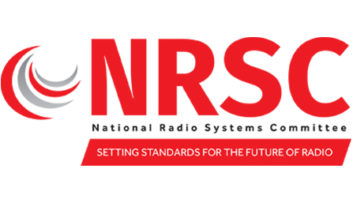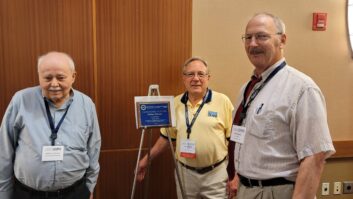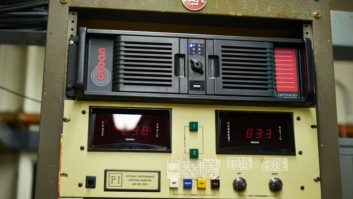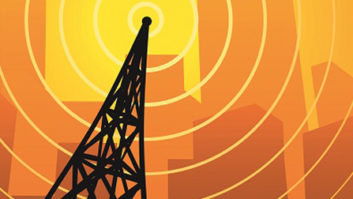Do You Measure Up?Question posed in the Apr. 14 issue
(Exam level: CBRE)
This Sunday night you are going to install a new HDFM exciter, which also generates the composite stereo signal. Are you required to do performance measurements?
a. No, as long as there is no change in modulation level.
b. Yes, because you’re a professional and you want to know that the station is measured perfect no matter that the program director says his “golden ears” are better than your test gear.
c. No, there is no FCC mandate to do this, and anyway performance is set by the manufacturer’s checkout.
d. Yes, under the general guidelines of 77.12966 b.3 any equipment change requires performance measurements.
e. Yes, 47 CFR 73.1590(a)(4) requires performance measurements when a stereo generator is first installed.
To help you get in the SBE certification exam-taking frame of mind, Radio World Engineering Extra poses a typical question in each column. Although similar in style and content to the exam questions, these are not from past exams nor will they be on future exams in this exact form.
The author has posted a correction to this article and further discussion about this topic, read it here.
Today’s question, shown in the box, serves two purposes: First, to once again remind you that the SBE exams are open book. You are allowed to take related reference material with you. Second, to remind you that you should carefully select and be acquainted with your reference choices before the exam. The exam room is no place to familiarize oneself with material that is several hundred pages long.

Gone are the days of hauling all that backbreaking test equipment up to the transmitter site such as this classic total harmonic distortion analyzer. Questions on operating practices and the related FCC regulations make up around 25 percent of the usual testing content of the Certified Broadcast Radio Engineer exam, and this proportion reflects the importance that compliance to these regulations represents as a part of our professional performance. Questions on safety, technical problems and related theory round out the question areas on the CBRE exam.
In the main, the FCC regulation questions you’ll encounter test you for two qualities: Are you familiar with the structure and organization of these regulations? And do you know, or can you readily access, the specific information in them?
We’ve discussed effective general test-taking strategies and how you can quickly dismiss many answers on their face. Even a general knowledge can eliminate many of the choices, so use this to your advantage.
Quickly reading over the possible answers for the question we’ve posed this issue should make you jaundiced of answer (d) immediately. Overall, the focus of the FCC is to enforce rules and regulations unique to this agency, which mainly is contained in 47 CFR (Volume 47 of the Consolidated Federal Regulations) and, if you’ve been at this long enough, you know there is no Part 77.
(click thumbnail)
Emissions mask for FM showing both the standard FCC mask in green and the HD Radio mask in red. Equipment performance measurements check for signal emissions outside these limits, which can potentially interfere with other stations. All of 47 CFR, even in tiny print, covers an entire bookshelf. Most of the specific regulations for broadcasting are contained in Part 73 for what used to be known as “main station” and Part 74 for what had been known as “auxiliary support services” such as translators and remote pickup links. The two sections have become blurred now as LPFM and translators for AM stations compete on an equal basis with more traditional “main stations.”
For instance, here in Hartford, there is a fill-in translator (Part 74) with a signal better than most Class A FMs. Since it carries the HD2 signal of the Class B main station, most listeners think that it’s just another full-power FM station (like those in Part 73).
Since only one choice has a specific reference in Part 73 for a main facility issue, a quick check of the rule shows its perfect relevance to the question, and there is the answer. Answer (e) is correct.
1590 (a) The licensee of each AM, FM, TV and Class A TV station, except licensees of Class D non-commercial educational FM stations authorized to operate with 10 watts or less output power, must make equipment performance measurements for each main transmitter as follows:
(4) Installation of FM subcarrier or stereophonic transmission equipment pursuant to § 73.295, § 73.297, § 73.593 or § 73.597.
A mea culpa: Careful readers of this column will probably have noted that the regulation overall paragraph identifier “a” was missing in last issue’s question printing. We printed 47 CFR 1590(4). I’m certain this probably caused our sedulous editor many sleepless nights as he tried to conjure up from the gray cells what was wrong with the answer selections.
Performance measurements should also be conducted for the following:

- • The initial installation of a new or replacement transmitter
- • Any modification made under 73.1690
- • Installation of an AM or FM basic/standard and/or a new HD generator/exciter
- • When specifically instructed by other rules or as a function of your FCC authorization.
In general, just about any component change in the system that could affect frequency stability, modulation envelope or adherence to regulation standards needs to be “proofed.”
The elaborate proof of performance requirements of the past covering audio response and distortion have been eliminated from Part 73. The common logic at present is that the competitive environment will take care of these issues. If a station really wants the most audience, the best sound, the greatest coverage, they will maximize the related technical performance because operating optimally is in ownership’s best interest.
The remaining “proof issues” are spectral purity concerns. Your quest to be the best should not take you outside of your assigned channel either from over modulation and/or from spurious signals caused by non-linearities in your plant’s operation. For the most part, these tests take on the form of spectrum analyzer reviews of occupied bandwidth.
The one and only occupied bandwidth test that must be made periodically within a mandated period of time is the AM occupied bandwidth measurement required annually. Each test must be made within 14 months of the previous. Overall the specifications for this are in 73.44 but if you’re running HDAM, you’ll need to at least meet the spurious requirements as well as staying under the HDAM IBOC mask that includes the adjacent channel digital sidebands.
FM occupied bandwidth is described by specifications in 47 CFR 73.317 for “traditional” FM but, as above for AM, you’ll use the HDFM IBOC mask for the sidebands in the adjacent channels on either side.
Missed some Certification Corners or want to review them for your next exam? See the “Certification” tab under Columns atradioworld.com.
What’s the Ratio, Kenneth?Question for next time
(Exam level: CBRE)
At 100 percent AM modulation, what is the ratio of peak antenna current to unmodulated current?
a. 16 to 1
b. 8 to 1
c. 4 to 1
d. 2 to 1
e. 1 to 1












